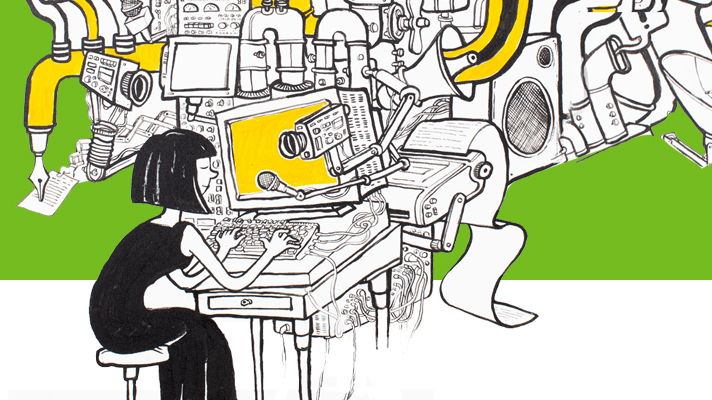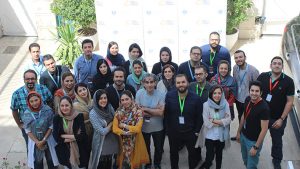
In the dnaunion Press Conference: Analyzing Developments in Iran’s Market with a Focus on the Impacts of COVID-19 and Sanctions
The annual conference of the dnaunion group was held with the participation of the group’s executives, including Naser Pashapour Nikou, CEO of dnaunion; Mohammad Mousavi, member of the Board of Directors and CEO of the communication agency Eshareh; and Kamyar Emami, CEO of the market and media research company EMRC. In this session, a report on Iran’s economic situation with a focus on COVID-19 and sanctions was presented. After the report, the group’s executives answered questions from journalists. Below is the full text of the presented report.
Naser Pashapour Nikou, CEO of dnaunion, stated: The review of Iran’s economy shows that the country has experienced one of the most challenging economic and social conditions in recent decades, largely shaped by two major factors: sanctions and COVID-19. Iran’s economic crises reached a peak in May 2018 when Donald Trump, the former U.S. president, violated and subsequently withdrew from the Iran nuclear deal (JCPOA). While Iran was already grappling with an economic shock and widespread social dissatisfaction, the COVID-19 pandemic, starting in early 2020, escalated the country’s crisis to a new level.
Declining Trend of Iran’s Gross Domestic Product (GDP)
Various economic and social challenges have slowed down the country’s economic momentum and reduced its GDP. With the return of sanctions in 2018, GDP began to decline. This trend accelerated with the onset of the COVID-19 crisis and related issues such as border closures.
International sanctions have significantly affected Iran’s economy, particularly its oil sector, which contributes a major share. In 2019, the oil sector experienced a -35% growth rate, leading to an overall -8.6% contraction in GDP. The shrinking of Iran’s economy continued in the spring of 2020 with a further 5.3% reduction.
The economic shrinkage has pulled Iran away from its developmental goals. According to the Vision 2025 Document, Iran was set to become the region’s leading economic power, requiring an average annual GDP growth of 8%. However, since the re-imposition of sanctions in 2018, the actual growth rate has diverged significantly from this target. By 2019, the deviation reached its highest point since the signing of the JCPOA.
The most significant consequence of this crisis was a sixfold devaluation of the national currency against the U.S. dollar compared to 2016.
Increase in Investments Following Rial Devaluation
Following the devaluation of the rial since 2016, Iranians sought to preserve their assets by investing in other markets such as foreign currency, gold, housing, and the stock exchange. During this period, the dollar rose more than sixfold, yielding a 61% return in 2020. Gold and coins saw an 8.9-fold increase since 2016. In 2020, coins had an 81% return and gold 73%. The stock index rose by 22% since 2016. Interest in the stock market surged from mid-2019, attracting significant liquidity in spring 2020. The stock market’s return in 2020 reached 157%. The housing market also experienced a fivefold increase from 2016, with an 83% return in 2020.
Unemployment Rate from 2018 Onwards
As economic conditions deteriorate, unemployment rises. According to the Statistical Center of Iran, the unemployment rate for individuals over 15 has shown a declining trend. In 2020, the rate was estimated at 9.6%. However, the Parliamentary Research Center reported the real unemployment rate in summer 2020 at 18.5%, more than twice the official figure.
Statistics on Divorce and Birth Rates are also telling indicators of Iran’s economic state. According to the Civil Registration Organization, in 2020, one divorce occurred for every three marriages—double the rate in 2011. Birth rates have also declined under the current economic conditions.
The rising trend of Iranian migration has recently drawn attention. According to the Iranian Migration Observatory, the number of Iranian migrants globally increased by approximately 28% between 2010 and 2019. Due to economic changes and sanctions in 2018 and 2019, the desire to emigrate among Iranian students abroad more than doubled.
Rising Inflation Since 2017
Runaway inflation in Iran has been another significant concern. According to the Statistical Center, the 12-month inflation rate ending in July 2021 reached 44.2%, the highest in recent years. This unstable and increasing inflation has led to higher living costs, including food and housing, affecting low-income groups the most.
Rising inflation has deepened poverty in Iran. In July 2020, the estimated cost of living for a family of four in Tehran was 8.8 million tomans. Of this, 25% went to a healthy food basket as defined by the Ministry of Health. In contrast, the poverty-line expenditure for a four-person household was estimated at half that amount, with 31.8% allocated to a minimum food basket. The poverty line in urban areas increased between 22.4% and 25.8% in summer 2018 compared to the same period in 2017. The poverty rate was estimated at 16% in 2017 and was projected to rise to between 25% and 35% by the end of 2018. Although no exact figure is available for recent years, it is likely that poverty levels have continued to rise due to ongoing economic deterioration since 2018.
The continuous decline in purchasing power is directly linked to the poverty line. Examining per capita GDP after the U.S. exit from the JCPOA reveals a consistent decline in purchasing power, with a 7.3% and 8.0% decrease in 2018 and 2019 respectively.
Additionally, data from the Household Income and Expenditure Survey of the Statistical Center of Iran indicates a decline in essential goods consumption. Red meat consumption dropped by 20-30% nationwide. In the third decile (near the poverty line), the impact was more severe: beef, lamb, and vegetable oil consumption fell by 36%, 24%, and 19% respectively.
31 Percent of People Are Seeking a Second Job or Overtime Work
Due to the mismatch between income and expenses caused by the economic crisis, households have faced multiple economic problems including cost management, livelihood and food provision, housing, and marriage. More than 90 percent of households are seeking solutions to reduce the impact of rising costs resulting from the crisis on their lives. Buying fewer essential items such as food and less essential items such as clothing, as well as changes in lifestyle patterns regarding recreational activities, are among the strategies that over 80 percent of households have adopted in response to increasing living expenses.
Furthermore, following the economic crisis, many Iranian households have postponed or canceled their planned programs.
In such circumstances, Iranian households try to rapidly change their behavioral patterns. According to conducted studies, 80 percent of households have made changes in their purchasing patterns to reduce costs. Shopping from cheaper stores, paying attention to and searching for discounts and promotions, and purchasing from cheaper brands are the most commonly used strategies.
Impacts of COVID-19: Mandatory Staying at Home, Unemployment, and Economic Problems
Following the COVID-19 crisis, 9 out of every 10 people were affected by the pandemic. More than one-fifth of individuals experienced staying at home, unemployment, and economic difficulties. Additionally, the time spent at home during the pandemic increased by 45 percent, rising from about 15 hours to 21 hours per day. Out of every 10 people, 2 experienced a reduction in recreational and non-essential activities outside the home. Psychological problems, depression, fear, and anxiety were other effects of this pandemic. According to the Statistical Center’s report in spring 2020 (1399 in the Iranian calendar), about 2 million people left the labor market due to the impact of COVID-19. Moreover, over 65 percent of individuals are worried about contracting the disease, lack of immunity, and exposure to the virus. More than 60 percent are concerned about job loss and income reduction. Mental health problems are among other concerns during the pandemic. Overall, more than 80 percent of people during the stay-at-home period caused by the pandemic spent more time with their families. Watching television more than before and spending more time on social media communications were other activities during this period. Half of the individuals dedicated more time to reading, learning new skills, and exercising.
Tehran and Changes Caused by the Economic Crisis and COVID-19
The sharp increase in living costs, especially in the metropolis of Tehran, has led to changes in the social and economic class structure of the population. In this change, shifts among different classes are such that the middle classes have grown, and about 45 percent of households in Tehran fall into the lower middle class.
About 73 percent of Tehran households make at least one major purchase of their necessities per month, paying on average 7.4 million rials per bulk purchase.
Due to significant price differences in discount stores, more than 30 percent of households refer to these stores for bulk purchases, placing them first in preference. Following these, large chain stores (such as Hyperstar, Shahrvand, etc.) and chain supermarkets (such as Yaran Daryan, etc.) are second, with over 20 percent of households shopping there for bulk purchases.
Approximately 70 percent of households go to local supermarkets and 15 percent to discount stores for small and non-bulk purchases, paying an average of 1.4 million rials for each small purchase.
Additionally, low-income households spend 10 percent less than average on monthly bulk purchases; the monetary value of each bulk purchase basket in these households is 25 percent less compared to affluent classes. Affluent households pay an average of 180,000 tomans for each non-bulk purchase, which is 30 percent more than the average.
After presenting the report, group managers answered journalists’ questions.
Naser Pashapour Niko, regarding the impact of the Protection Plan for Users’ Rights in Cyberspace on digital marketing, said: “This plan does not cause problems in a country that is not under sanctions. The problem arises when the country is sanctioned. In this plan, it was requested that international companies have an office or representative within four months. This is not unusual; however, the problem is that these companies cannot have an office or representative in the country due to sanctions.”
He continued: “This issue can be viewed from several angles. First, the essence of the internet is based on the free flow of information, and imposing restrictions—whether in terms of bandwidth, filtering, or limiting content—is against the free flow of information.” According to Pashapour, with the implementation of this plan, in the dimension of advertising and marketing, the lack of alternative media is one of the challenges. He also stated: “Currently, there is no social network to replace Instagram. From an advertising and marketing perspective, our biggest problem is the absence of alternative infrastructure for social networks at present.”
Mohammad Mousavi, CEO of Etteghat Tasvir Advertising Agency, mentioned the impacts of the Protection Plan on digital marketing: “We are still faced with a plan that has not taken the form of legislation and remains subject to speculation among experts regarding its details. But generally, if the assumptions circulating in society come to pass, many companies active in content production and businesses advertising online will face difficulties and their activities will be restricted. Therefore, there are currently prejudgments about the Protection Plan—prejudgments that have, in some cases, also caused harm.”
Pashapour, regarding the rising prices imposed on Iran’s economy and the resulting demand and effects on economic enterprises, said: “Supply and demand depend on each other. When there are buyers in the market, naturally prices will rise. In a free market economy, the market determines the price. When our borders cannot adjust to the global exchange rate, smuggling occurs. This smuggling will increase as long as there are buyers; therefore, we will continue to see price increases in consumer goods.”
Mousavi added: “Some industries depend up to 80 percent on importing raw materials. The increase in the dollar exchange rate and import problems for goods and raw materials have caused price increases. Production costs in market sectors have also risen. Accordingly, companies need to increase prices to survive in the market. On the other hand, many industries depend on government subsidies. This has made some goods attractive for export, but due to the lack of raw materials, production is low and prices rise. This is the situation we see in the oil market.”
Pashapour, regarding private sector investment, said: “We all witnessed investments in the stock market because the stock market benefits from basic export commodities like copper. On the other hand, the exchange rate affects the profits of companies exporting raw materials. Most investments have been attracted to the stock market; therefore, the largest investments have been in companies exporting raw materials. Also, companies that received subsidized foreign currency at 4200 rials invested in their activities or expanded their businesses. For example, one pasta manufacturer invested in chocolate production. Such investments are very minimal. Overall, there is a severe weakness in investment in our country.”
The DNAUnion group has also made investments in advertising and marketing technology over the past two years. These investments have led to the production of new services, which can be divided into three categories. One category of these services has enabled us to serve clients who previously could not be served. Another category has facilitated work and reduced costs, including tools such as OHM and HHP. The third group of services involves offering new technologies that add new capabilities to the country’s marketing industry. For example, linking outdoor campaign results to navigators has allowed us to estimate the number of viewers of each billboard. Overall, our group has introduced eight new technological products to the country’s marketing market. These products help us provide new information to businesses. In general, the economy is like sports: until we enter global competitions, we will never become professional athletes. In my opinion, despite all the opposition to the 25-year contract with China, if we can sign similar contracts with 11 developed countries, we can open the economy and achieve desirable results. We hope the new government will provide this opportunity and enlarge the economy’s size and improve the livelihood of the people.
Emami, regarding the effects of COVID-19 on digital marketing and online shopping, said: “Based on conducted research, the rate of online shopping in Tehran during the COVID-19 period is 9 percent, and it is likely that this figure has increased compared to previous years. One observed change during the pandemic is the shift in consumers’ purchasing channels. About the research tools presented by the group, such as OHM, I must say: the lack of a reference source for outdoor advertising activities and having accurate information about advertising structures, screening status, competition environment, and ultimately the evaluation of effectiveness indicators, such as exposure rate, are among the challenges businesses face in outdoor advertising campaigns. This information helps advertising agencies for optimal planning and brand owners to ensure the accuracy and effectiveness measurement of outdoor campaigns. To this end, and to obtain this information, an application called OHM has been provided to operational users. These users can view information on all billboards on city routes and continuously collect monthly screening status data. Using this application, operational users can easily record the screening status information of observed billboards and send it along with a photo of the billboard. The data from these tools have been made available to businesses and have gradually gained greater acceptance.”
Mohammad Mousavi, CEO of Etteghat Tasvir Company, also referred to the effects of COVID-19 on digital marketing: “Since the start of the pandemic, according to reports, people stayed home more, watched television, and the public interest in VOD platforms such as Filimo and Namava increased. We witnessed about a 40 percent increase in social media use, and there was a boom in internet businesses.”
He continued: “Regarding increase or decrease in marketing and advertising activities, in my opinion, no change has occurred and traditional media still lead advertising activities.”
According to Mousavi, with the emergence of new platforms such as VODs and their increased popularity during this period, this sector can be added to the marketing communications portfolio.
Mousavi also responded to the question of why businesses do not increase their digital marketing budgets: “We are facing a new advertising environment and digital marketing is still new in our market, which causes budget effectiveness to be lower and companies tend to allocate their budgets cautiously and thoughtfully to these areas. The budget for digital marketing has increased year by year; however, I believe this sector is like a bud that is slowly growing.”
He added: “Still, considering the cost-benefit ratio and the amount spent on digital marketing to inform people, it is not yet cost-effective compared to other media such as radio and television. Also, content production and response in this space require much greater investment by companies, and many companies need to take advantage of the opportunities created and respond more quickly to developments.”





